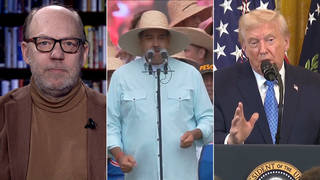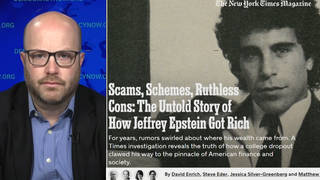
Topics
The leader of the movement to look at history from the perspective of people of color and the powerless in our society is Howard Zinn, author of A People’s History of the United States: 1492 to the Present. In honor of Indigenous Peoples’ Day, we now bring you an excerpt of a speech by Howard Zinn. [includes rush transcript]
Transcript
AMY GOODMAN: The leader of the movement to look at history from the perspective of people of color and the powerless in our society is Howard Zinn, author of A People’s History of the United States: 1492 to the Present. In honor of Indigenous Peoples’ Day, we now bring you an excerpt of a speech by Howard Zinn.
HOWARD ZINN: I became a historian relatively late. That is, I was a freshman in college at the age of 27 when I started to study history, and I had done a number of things before. But by that time, I already knew that I wanted to be—I wanted to teach history, and I wanted to write about history, and I knew that I would not be a neutral historian. Well, I knew that there was no such thing as neutrality in history, no such thing as objectivity, although that word was thrown to me again and again and again, and it is still used by historians, and they still talk about—where did I see it most recently? Oh, Arthur Schlesinger, Jr., yeah, in his little book. That’s a—I know, that’s a slam, his very little book about multiculturalism, you know, and talking about the melting pot and how that’s how he sees America: a melting pot. And he talks about the importance of doing disinterested history. That word “disinterested” has been used a lot. And I never believed in doing disinterested history. I didn’t believe it was possible to do disinterested history. History always represents interests of one sort or another. History always has an effect.
My first teaching job, my first real teaching job—I had a number of unreal teaching jobs—my first real teaching job was in the South, in Atlanta, Georgia. I taught at Spelman College, a college for black women in Atlanta. I taught there for seven years, from 1956 to 1963. You know, those were the years of—those were important years. Those were the years of the civil rights movement and of turmoil, and they were very exciting and still perhaps the most intense experience of my life. And I became involved in the movement. I became a kind of participant, what sociologists call a “participant observer,” or participant writer. I was involved in the movement, and I began writing about it for The Nation and for Harper’s, and became involved with SNCC, Student Nonviolent Coordinating Committee. And I began to think about history from the black point of view, because it’s hard to live in the black community and teach in a black college without beginning—at least beginning to think of history from a different point of view.
And everything looks different in history when you look at from the black point of view. If you take just something like the Progressive period in American history, anybody who studies history goes through and there’s always a period called the Progressive Era or the Progressive period in American history, which is the first years of the 20th century, roughly between 1900 and, you know, World War I, the Progressive period. Why is it called the Progressive period? Well, because some reforms were passed, right? The meat inspection—Meat Inspection Act was passed. You notice how good our meat is? Meat Inspection Act, railroad regulation, 16th Amendment, 17th Amendment, Federal Reserve Act—this is what you learned in school, right? You got multiple-choice questions about—to see if you knew the difference between, you know, the Federal Trade Commission and the Federal Reserve Commission. And if you read a black historian, which I read while I was teaching in Spelman College, a black historian named Rayford Logan, who wrote exactly about that period—he didn’t call it the Progressive period, he called it “the nadir,” the bottom. The Progressive period was the period in which more black people were lynched than any other period in American history. And still it continued to be called the Progressive period in American history.
So, from a black point of view, all the presidents of the United States look different. Lincoln looked different. Lincoln suddenly was not, you know, the Great Emancipator represented in that statue with the black kneeling before him gratefully, you know, where Lincoln bestows emancipation. From the black point of view, or from any decent point of view, Lincoln was a reluctant emancipator. Lincoln had to be pushed into it, by a movement, by an anti-slavery movement, by black abolitionists and white abolitionists, by a crescendo of criticism of him for not doing anything about slavery, even while a civil war was going on and even after the South had seceded. You know, Lincoln looks different.
Roosevelt looks different. Did any of you see this new series on the Great Depression? There are some—a few of you are nodding your heads, so a lot of you haven’t, I assume, right? I won’t berate you for not seeing that, but it’s very good. Some of you may know the series Eyes on the Prize, and this is a little follow-up by the same producer, Henry Hampton, and it’s about the Great Depression. And the interesting thing about this, about the Great Depression, is that black people and their point of view—and I guess because Henry Hampton is doing it—are much more evident in looking at the Great Depression. And so, he points out to what anybody who has studied FDR fairly closely knows, that Roosevelt, who was, you know, I guess, one of our best presidents, in many, many ways—no question—but Roosevelt would not support the passage of an anti-lynching law in Congress, because he was tied in with the Southern Democrats and dependent on their political support.
Same thing with Kennedy. Kennedy, you know, the liberal president, the young and, you know, we all know the good things about—that everybody believed about Kennedy. But from the point of view of people in the movement, people in the South in the movement in the early 1960s, Kennedy was no civil rights advocate. Kennedy appointed racist segregationist judges in the deep South, in Alabama and Georgia and Mississippi. Kennedy’s Justice Department stood by while people were being beaten, and Kennedy didn’t respond. Same thing with his attorney general, Robert Kennedy. Heroes look different, everything looks different, when you look at it from a different point of view. So all of these things affected my thinking about history.
When I first began to—when I decided to write A People’s History of the United States, and I guess I decided to write it because I was looking for a book like that, and I couldn’t find it. So I wrote it. That very often is why—how books get written. You look around for something, and you think, well, surely something—somebody must have done this, because it’s needed. You know, somebody has to write a history book from a point of view which is different than, you know, what has been done before. I couldn’t find it, so I did it, and I made up my mind that I was going to tell the history of the United States from a different point of view. I was going to tell the story of Columbus from the standpoint of the Indians, because we never got that. The Indians were always—you know, who were they? You know, a blur in history.
I wanted to tell the story of the Mexican War from the standpoint of the Mexicans. It looks different that way. From the American point of view, we won the war, as we always do—well, until recently. But—and it was great! We ended up with California and all of this territory. The Southwest all belonged to Mexico, and we got it. From the point of view of the Mexicans, there was a war instigated by the United States, planned by President Polk even before that incident took place in 1846 between the Nueces River and the Rio Grande River—planned, just as so many—you know, just as the United States wanted the Philippines, and there was an incident just at the right time, and the United States wanted to move into Vietnam, and there was an incident in the Gulf of Tonkin. A lot of manufactured incidents. And so, I just wanted to introduce different points of view.
I wanted to tell the story of the Industrial Revolution in the United States, which I had always learned, and when I went to school, in a very inspiring way. And I remember as a kid, as a high school kid, actually feeling proud that America had become this great industrial power, that period between the Civil War and World War I, the steel mills going up and the—you know, they would give us figures on how much coal was produced this year and how much coal was produced 20 years later, and the railroads spanning the country, and the Transcontinental Railroad being built, and the Union Pacific and the Central Pacific meeting, and the president driving a golden spike through the last—you know, right—rails, and very exciting. And that story is still being told that way, for the most part. And I wanted to tell that story from the standpoint of the people who worked in the steel mills, the people who worked in the mines, the people who worked on the railroads, the Irish immigrants and the Chinese immigrants who were brought in to work on the Transcontinental Railroad and who died by the thousands working in the heat and the cold, getting sick, working long hours and dying of exhaustion. That’s a different point of view about this great Industrial Revolution. It makes you think about all industrial revolutions.
It makes you think about—no, I’m not about to say, “Let’s go back to the cave.” You know, you’re always accused of this when you criticize the way industry has functioned or the way industry has been built or the way—you know, you’re always accused of being—wanting to go back and not having dishwashers, you know. And no, it’s not that. But it’s important to understand, even though you want progress and you want—sure, you want new things to be produced, but it’s important to understand the human cost of that, and whether you must pay that human cost in order to have progress or whether you can have progress without sacrificing human beings.
AMY GOODMAN: Howard Zinn, author of A People’s History of the United States, here on Democracy Now!. We’ll be back in 60 seconds.











Media Options